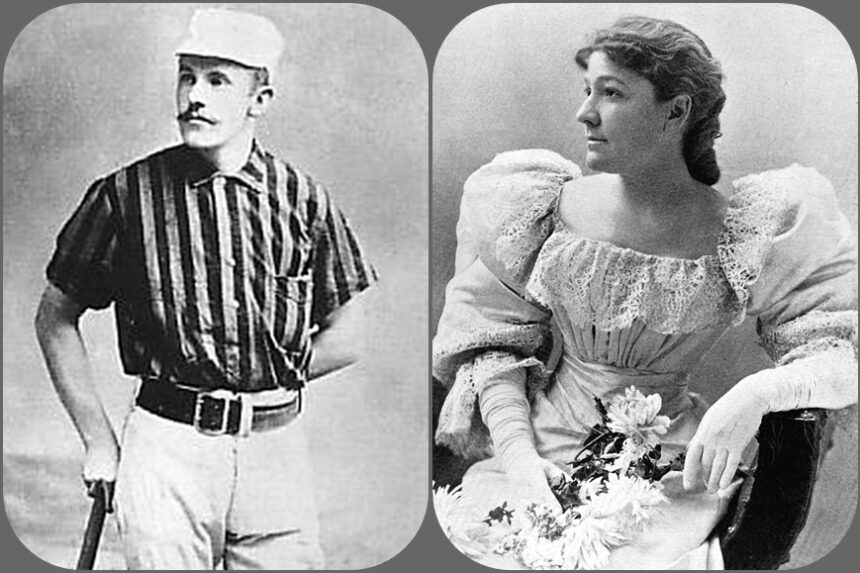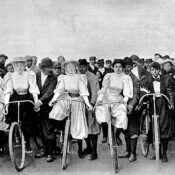Everyone who’s the least bit plugged into the NFL or popular culture, or has spent at least five minutes out of a coma the past few months, knows why the Kansas City broadcast keeps cutting to the Chiefs’ luxury suite. Shots of Taylor Swift cheering for Travis Kelce are now seamlessly part of television coverage. Is it love? Is it a publicity stunt? Why does the media follow their every move so breathlessly — and why is America following along?
Only time might answer the first two questions, but history can help with the third.
Long before there was a Taylor and Travis (or, for that matter, a Marilyn Monroe and Joe DiMaggio), actress Helen Dauvray and baseball player John Montgomery Ward were the ones dominating the headlines of their day. The Dauvray-Ward romance and the media coverage it received offer a glimpse into the future of the celebrity power couple, from a time when entertainers and professional athletes were still socially suspect in the minds of the Gilded Age elites who valued the perceived purity of amateur pursuits.
In the late 19th century, the concept of publicity was starting to evolve. Instead of earning fame and media coverage through political or charitable deeds (or misdeeds), Americans started becoming newsworthy just by being well-known, in part due to the development of the celebrity interview, which both responded to and stimulated public interest, thus establishing a self-reinforcing public relations loop.
Helen Dauvray, the headliner of her own theatrical troupe, was a fixture of this loop. So famous was she that a October 12, 1887 New York Times article previewing her impending marriage to Ward identified her as “the well known actress” whose “history is too familiar for detail.” The journalist didn’t bother reprising Dauvray’s rise to fame as 1860s child performer “Little Nell,” and glossed over the actress’ time on the stage as Helen Gibson before she reinvented herself in Paris and changed her name because readers already knew the story; Dauvray had received 66 mentions in 1887 in the Times alone, not counting classified ads.
Her beau, John M. Ward, could not compete with Dauvray’s megawatt stardom. “[T]he man she is to marry is not so well known, although he has made a reputation on the diamond,” that same Times profile noted, providing readers with a thumbnail sketch of Ward’s baseball career so they could catch up: He’d won one championship, received bachelor’s and law degrees from Columbia, and had a role in founding the Brotherhood, the first labor union for major league baseball players. Not mentioned were the facts that Ward had pitched the second perfect game in professional baseball history, moved from pitcher to outfielder and shortstop, and served as player-manager of both the Providence Grays and New York Giants — all after allegedly being kicked out of Penn State for stealing a chicken.
If Times readers required a 101 course in Ward, no such introduction was necessary for enthusiasts (“fans” was just coming into usage) who subscribed to the Sporting Life or the Sporting News, the recently founded weeklies that were the ESPNs of the 1880s. The front-page story in the October 19 issue of the Sporting Life called the Dauvray-Ward marriage “the sensation of the week” in “base ball,” which still appeared in print as two words.
The first breadcrumb of a Dauvray-Ward relationship appeared in late May 1887, when newspapers announced the actress’s gift of her self-named trophy, the Dauvray Cup, to be presented to the winner of a postseason championship series. On July 20th, her name was linked to Ward obliquely when Sporting Life identified her as a “perfect crank” — 19th-century slang to describe an obsessive, unreasonable person — for his team, the New York Giants. Only in September did the first direct connection to Ward surface, when Dauvray mentioned him in a letter to the National League president that Sporting Life quoted from. Dauvray and Ward were not linked romantically until their Times marriage preview on October 12, just one day before they publicly tied the knot.
After the bombshell news dropped, papers were full of speculation about the couple, who were perhaps trying to avoid this very type of rumor-filled attention by keeping their relationship secret up until that point. As MLB historian John Thorn has established, the two had, in fact, first gotten married a month and a half before the Times reporter’s visit, on August 31, 1887. Was Dauvray playing games with the press when she didn’t admit to this on October 11? Doing so might have saved the couple a trip to Philadelphia the next morning to get married a second time.
The mystery around their coupling deepens when you consider an October 17 Detroit Tribune report that Thorn surfaced, which observed that the “newlyweds” appeared to be anything but happy: “[Ward and Dauvray] haven’t been married a week, but they didn’t seem particularly affectionate,” the Tribune correspondent wrote. “Ward shouted for the Detroits and Mrs. Ward applauded for the Browns … They occupied opposite ends of the box, and hardly spoke to each other during the contest.”
Reading between the lines more than 100 years later, such coverage raises the question of whether they were leveraging their relationship for attention, or if they were genuinely attempting to avoid feeding the rumor mill of 19th-century journalism. If they were seeking publicity, it’s worth asking for what end. Of the two, Dauvray would have benefitted the most from an image boost at that moment; the news of their relationship may have helped her recapture headlines after she canceled her fall season in early September following reports of a serious illness. Ward’s exploits on the field (he led the league with 111 steals that year) and the contract negotiations between the Brotherhood and the National League already kept him at the forefront of the sporting press.
After the hoopla surrounding the marriage subsided, the couple assumed a lower profile. Initially, they may have tried to stay out of the news after Dauvray’s brother was arrested and charged with sexually assaulting a servant (the charges were later dropped). But minimal details were also given about their westward honeymoon travels in November, except that Dauvray intended to appear on stage during a charity event in San Francisco. This last detail seems to indicate that Dauvray, despite having announced her retirement from the stage following their marriage, was not ready to leave the limelight. Such speculation is supported by the pattern that developed over the next two years in the press: Dauvray’s name perennially appeared in the theater gossip column of the New York Times, where her return to the stage would be promised, only for those plans to be scuttled by some difficulty or illness.
Ward’s name, meanwhile, was in front of the sporting public regularly due to the mounting labor struggle between the Brotherhood Union and the National League. When that struggle came to a head in 1890, Dauvray and Ward received increased media attention again. As the leader of the Brotherhood, Ward was the face of the union’s labor war with the National League. In the reports of Ella Black, a Pittsburgh correspondent for the Sporting Life, Dauvray was credited as being perhaps both the inspiration for and the cause of the new major league formed by Ward.
That same year, in 1890, the Cosmopolitan published perhaps the most telling piece of media around the Dauvray-Ward romance: a satirical short story that was part roman à clef melodrama and part Connecticut Yankee in King Arthur’s Court. Ward was recognizable as Algernon de Witt Caramel, the “Champion Short-Stop of America.” Dauvray appears as Miss Violet Veronica Van Sittart, “our hero’s peerlessly beautiful fiancée.” The story ended with the young couple, living off the millions Caramel made as a shortstop, “doing very nicely indeed.”
Given that John Ward’s salary was $3,000 in 1887, the idea that a baseball player would ever earn millions of dollars for playing a child’s game hints at the key to the story’s satire. Because magazines like the Cosmopolitan were written for an upper-class audience, the editor likely chose the story not because it painted the couple in a positive light, but rather because it encouraged an elite audience to laugh at the efforts of professional actresses and ballplayers to rise above their stations.
In real life, Dauvray and Ward’s union was short-lived; 1890 was also the year that newspapers quietly announced the couple’s separation. Though it was not public knowledge at the time, Ward had also been seeing actress Jessie McDermott, according to Ward’s biographer, Brian Di Salvatore. Equally small notices chronicled their divorce three years later.
From its supernova start, the dissolution of Dauvray and Ward’s marriage is most notable for its understated silence. Nonetheless, for a brief, shining moment in the late 1800s, enthusiasts of the lime-lit dramatic boards and dusty ball diamonds could thrill at this uniquely American aristocratic union that served as a trial run for Marilyn and Joltin’ Joe 60 years later, and now again with Taylor and Travis in this century—when the millions in question have become a matter of billions.
Originally published on Zócalo Public Square. Primary Editor: Sarah Rothbard | Secondary Editor: Jackie Mansky
Become a Saturday Evening Post member and enjoy unlimited access. Subscribe now




Comments
Concerning Helen and John here, they were extremely shrewd at using the media of the late 19th century to their advantage without the benefit of experts and ‘handlers’ to create the desired results using effects created by the illusions and perceptions they wanted; including sleight-of-hand as needed. It worked for awhile, until it couldn’t and didn’t any longer. That’s usually the way it still goes, not surprisingly.
What really frosts people is that she is a intelligent, successful, engaging, creative WOMAN! She is also a billionaire who does not keep everything for herself, but offers incredible pay as well as outstanding bonuses to all who work for and with her from the musicians, performers, stage crew, and truck drivers. She gives away incredible amounts of money to charities. She is a positive, hopeful, energetic role model for young girls, as well as for all the men who disparage her so easily. We need more Taylor Swifts in our world.